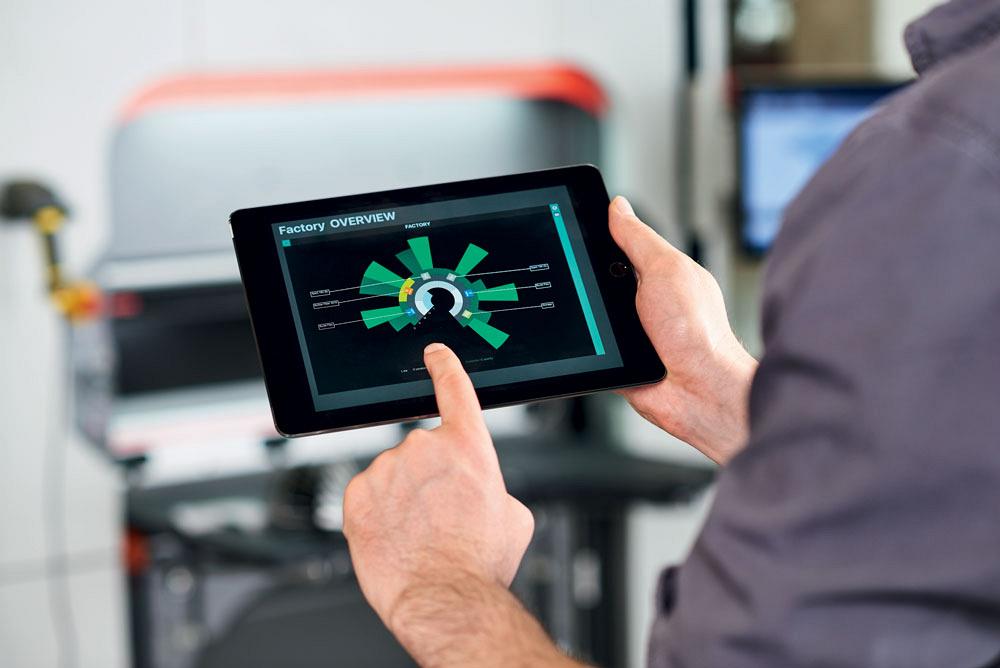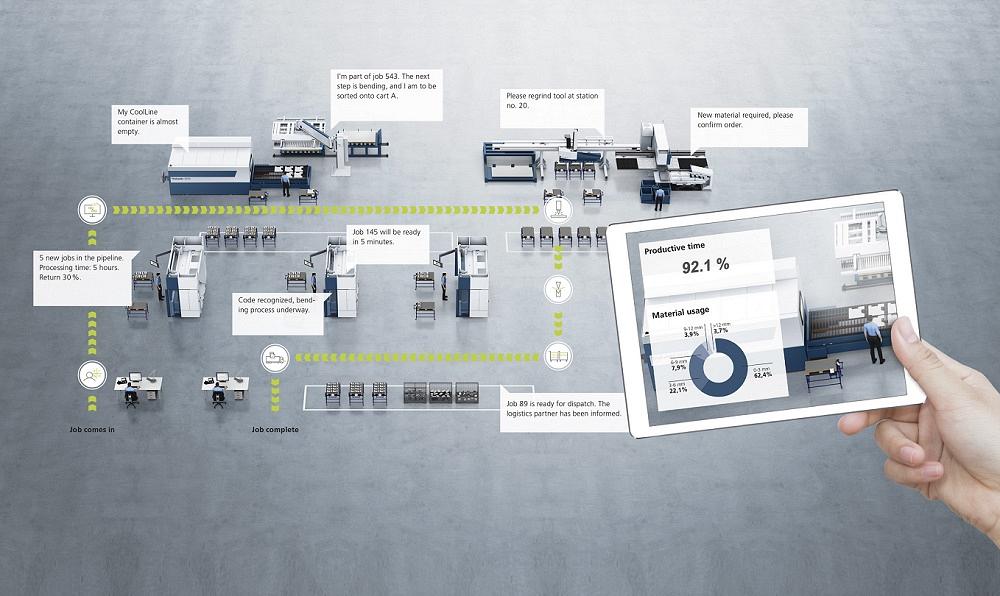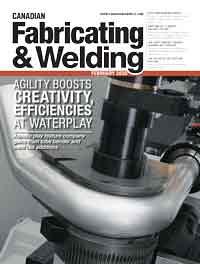Associate Editor
- FMA
- The Fabricator
- FABTECH
- Canadian Metalworking
Mapping out a smart factory future
Making the transition from legacy factory to factory of the future takes more than just investment in equipment
- By Lindsay Luminoso
- February 5, 2020
- Article
- Automation and Software

The Bystronic ByCockpit App analyzes and visualizes selected key indicators regarding machine performance and manufacturing efficiency, making the quality, times, and cost of production transparent and optimizable. Photo courtesy of Bystronic.
According to a McKinsey report, "The Internet of Things: Mapping the value beyond the hype," the potential economic impact of the IoT in the factory setting could reach nearly US$3.7 trillion by 2025. Overall, the report estimates IoT has a total potential economic impact of up to $11.1 trillion across all settings. Connecting the physical and digital world, especially in the manufacturing sector, has become increasingly popular over the past few years. Today’s fabricators can leverage the latest technology and take their piece of the proverbial pie by mapping out a smart factory future.
Have a Vision
"The question for fabricators is no longer whether they participate or not, but rather simply when and where do they start," said Tobias Mauz, head of sales—software solutions, TRUMPF North America, Chicago, Ill.
"Together with our customers, we identify inefficiencies and potentials in both their direct as well as indirect processes. Based on those outcomes, we design an individual step-by-step plan to develop their own smart factory with streamlined processes resulting in a higher efficiency. It’s really about how to best take advantage of the latest technologies and, in the end, how to best get ahead of their competitors."
The target for smart factory automation should be increasing efficiency and productivity on the shop floor and in the back office. It’s not good enough to just integrate a new software system or automation technology for the sake of it. There should be a strategy or vision guiding how smart factory automation is added. Fabricators can start with making a list of the data they are looking to capture and the tools they think will help improve their processes. From there they can have a conversation with automation and machine manufacturers about what options are available and how digitalization can help improve efficiency, as well as how implementation of smart factory technology will generate payback.
"The modularity of the automation solution—that the system can be built step by step, piece by piece—minimizes the initial investment and can grow over time as the business grows," said Roberto Nicoli, managing director, Bystronic Canada, Mississauga, Ont. "For example, fabricators can invest in a single laser cutting system first, add automatic material loading/unloading later as step two, a storage system as step 3, and connect multiple cutting and bending equipment as step 4 in several years if they want. This modular concept of the new smart factory is very appealing."
With so many options available to fabricators, it is important for them to have a step-by-step, goalbased process for implementing smart factory automation. This approach will allow shops to be ambitious but also generate payback early on in the process. Modularity of these systems gives a shop the flexibility to assess previous steps and see if and how they are meeting shop floor needs. They can then decide to continue forward with the initial plan or adapt it to better suit current needs.
Challenge the Data
Smart factory automation is not just about adding hardware to the shop floor and running lightsout operations, although those are certainly part of it. The experts agree that smart factory automation is about providing connectivity and transparency through a synergy between software and hardware.
"Transforming the shop floor is not just about adding a dashboard and showing that the machine only runs 30 per cent of the time," said Mauz. "It’s certainly useful to have this information, but that is only the first step. But how does having this information help fabricators make better decisions, and how can it be used to make future decisions to help improve efficiency?"
Having real-time data capture helps fabricators measure the health of their processes and make informed decisions about future activities and investment opportunities. Moving step by step from one machine and slowly onboarding all machines so that the entire floor is connected is a great way to build a strong smart factory infrastructure.
"Fabricators are looking to connect the entire process," said Nicoli. "Through more efficient, user-friendly offline programming software, machine operators are able to connect an ERP system from one side with equipment on the other, moving data and information within a closed loop."

Machines and components communicate with one another with the aid of sensors and codes. Software solutions collate the information obtained, analyze it and use it to control the manufacturing process. Photo courtesy of TRUMPF.
Smart factory automation can be applied across many areas of the shop floor, to both direct and indirect processes. It’s not enough just to put a dashboard on a legacy machine; software and automation technology must be found that helps increase productivity of these machines to help improve down-the-line processes. With new machines getting faster and smarter, it’s important for fabricators to look at all areas of production and use data to see where efficiencies can be gained. With so many options available, datadriven decisions will help fabricators plan better for the future.
Optimize the Shop Floor
"Over the last three years, our customers have been increasingly looking at automation," said Nicoli. "We saw this trend start with the laser cutting portion of the fabrication process because the performance of the fibre laser was becoming extremely fast."
As new cutting, bending, automation, and software technologies continue to advance, the perception that automation is expensive and practical only for high-volume production is also changing, Nicoli added. Shops focused on high-mix/low-volume production can now take advantage of automation because of the simplicity of today’s easy-to-use programming software. Where programming a single part for a robot might have taken hours in the past, advanced technology has turned that time into minutes, making it more accessible for smaller production runs.
"We find fabricators are investing heavily in automated material loading/unloading systems with storage capacity," said Nicoli. "Further, over the last 12 to 24 months, automation requests are shifting downstream to the bending department."
Developing a vision that connects the right direct and indirect processes together is key to the overall success of smart factory automation. Today’s fabricators must look at the areas where they can improve and where they are already maximizing efficiency. It’s easy to get swept away in all of the exciting, new technology available on the market, but strategic implementation of automation and software will make for a smoother transition.
Get Everyone On Board
One of the biggest challenges facing much of the manufacturing industry is the lack of skilled employees. This is why smart factory automation is such an attractive option.
"Many fabricators have grown impressively fast in the last few years," said Mauz. "And suddenly now they have reached a size where established processes have become outdated and they find themselves in the middle of digitalization and this smart factory world to overcome these inefficiencies. The technology surrounding these trends has changed so much in the last few years that there can be a lack of in-house knowledge. Those new technologies can be overwhelming. This is why we offer consultation along the entire process, from sales in the beginning, through the implementation on-site, to the support of the system. Throughout the process, we not only want to focus on management, but also include shop floor workers to ensure a smooth transformation that will gain the greatest benefit."
Nicoli added that with today’s automation capabilities; user-friendly controls; and powerful, easy-to-use software on new machines, shops don’t require that high level of operating expertise that was mandatory years ago. The experts agree that opting for a step-by-step strategy is the right way to go. A slow and steady approach to smart factory automation makes it easier for shop floor workers to learn how the shop floor will change and adjust to meet new demands.
"You don’t want to change too much at once, rather break it into different steps," said Mauz. "With this approach, people can familiarize themselves with new tools and learn how to use them without becoming overwhelmed. It’s so important to have shop floor workers on board with the new technology, not just management, in order to fully take advantage of those established solutions."
Associate Editor Lindsay Luminoso can be reached at lluminoso@canadianfabweld.com.
Bystronic Canada, www.bystronic.ca
TRUMPF, www.trumpf.com
About the Author

Lindsay Luminoso
1154 Warden Avenue
Toronto, M1R 0A1 Canada
Lindsay Luminoso, associate editor, contributes to both Canadian Metalworking and Canadian Fabricating & Welding. She worked as an associate editor/web editor, at Canadian Metalworking from 2014-2016 and was most recently an associate editor at Design Engineering.
Luminoso has a bachelor of arts from Carleton University, a bachelor of education from Ottawa University, and a graduate certificate in book, magazine, and digital publishing from Centennial College.
Related Companies
subscribe now


Keep up to date with the latest news, events, and technology for all things metal from our pair of monthly magazines written specifically for Canadian manufacturers!
Start Your Free Subscription- Industry Events
Automate 2024
- May 6 - 9, 2024
- Chicago, IL
ANCA Open House
- May 7 - 8, 2024
- Wixom, MI
17th annual Joint Open House
- May 8 - 9, 2024
- Oakville and Mississauga, ON Canada
MME Saskatoon
- May 28, 2024
- Saskatoon, SK Canada
CME's Health & Safety Symposium for Manufacturers
- May 29, 2024
- Mississauga, ON Canada




















